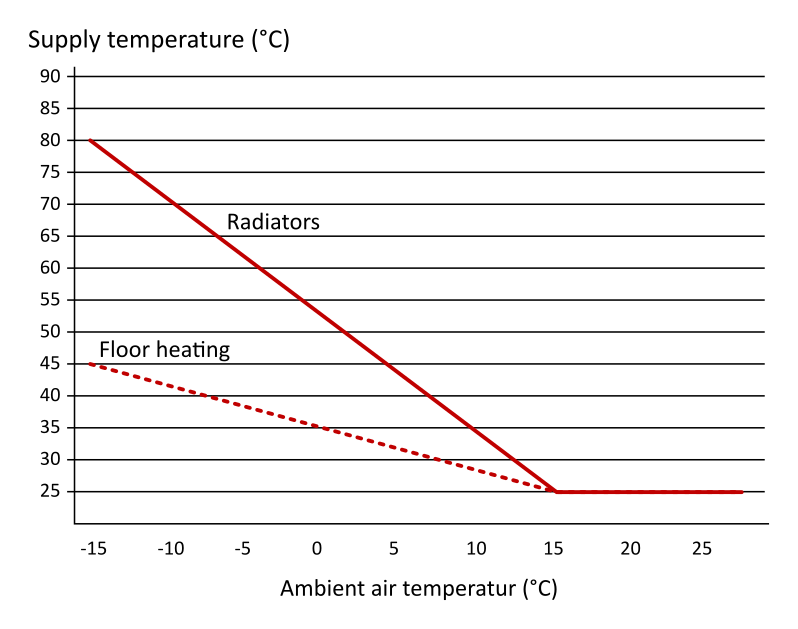Heating curve for building energy systems
On this page you will learn how to include a heating curve in nPro for the calculation of a building energy system.
What is a heating curve?
The heating curve of a building energy system describes the supply temperature as a function of the ambient air temperature. If the ambient air temperature is very low in winter, the supply temperature is usually increased, e.g. from 60 °C to 80 °C. This causes the radiators (or underfloor heating) to give off more heat to the room. It also reduces the mass flow in the pipes, as the temperature difference between the flow and return increases. Lower mass flows result in lower pressure drop and smaller pumping work.
How does a heating curve look like and where are they used?
Two exemplary heating curves are shown in Figure 1. At the lowest ambient air temperature, the supply temperature is 45 °C for floor heating and 80 °C for radiators. At ambient temperatures above 15 °C, the building requires very little heating power and the supply temperature drops to 25 °C. In many cases, a linear relationship is assumed between maximum supply temperature in winter and the point of the lowest supply temperature in summer.
Consider heating curves in nPro
In the "Load profiles and heat network" module of the nPro tool, the corresponding building energy systems must be defined when calculating 5th generation district heating and cooling networks (5GDHC). In 5GDHC networks, a water-to-water heat pump is installed in each building, which raises the temperature level of the heat from the heat network to the required supply temperature of the heating system in the building. The efficiency of these heat pumps depends strongly on the temperature lift. This leads to the fact that the lowest possible supply temperature in the building energy system should be aimed for. This maximizes the coefficient of performance (COP) of the heat pump and minimizes its power consumption.
Therefore, two different heating curves can be selected in the nPro tool: Either the supply temperature is constant throughout the year and thus independent of the ambient air temperature. Or the supply temperature decreases linearly with increasing ambient air temperature. The assumption of a constant supply temperature is often good for existing buildings, since these do not have an ambient air-guided control system. For new buildings, the assumption of a sliding supply temperature is more suitable. In this case, the option of the variable heating curve in nPro should be selected.

How is the heating curve taken into account in nPro?
In nPro, the approach shown in Figure 1 is used: At ambient air temperatures of 15 °C or above, the supply temperature of the heating system is 25 °C. At the coldest hour of the year, the supply temperature is the maximum supply temperature of the heating system specified by the user. Between these two points, the supply temperature is linearly interpolated for outdoor air temperatures below 15 °C.
Sources
This might also interest you
nPro software
Plan your energy system with nPro!

 English
English
 Deutsch
Deutsch


